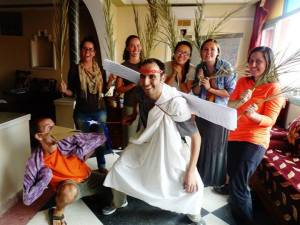At the beginning of September, Matt and I traveled to a town a few hours south of us called Ouarzazate to attend a 10-day language training workshop. This time we weren’t learning Darija, but instead a language called Tamazight, which is one of the languages of the Amazigh people.
The Amazigh were living in Morocco long before the Arabs came to North Africa, and are considered the indigenous population of Morocco. Upon the arrival of the Arabs, the Amazigh people were pushed farther and farther into the less inhabitable areas of the country, such as the mountains and the desert, and as a result you can still find large pockets of Amazigh peoples living in those areas. Azilal is one such area – almost everyone we’ve met here speaks Tamazight – although as a larger town, most people do also speak Moroccan Arabic.
I really enjoyed this training because, along with the language, we got to learn a bit about the culture and history of the Amazigh, which I found fascinating. I’ll try not to bore you with too many details, but I want to share some of the things I found most interesting.
- The Amazigh people live in modern-day Morocco, Algeria, Tunisia, and Libya. They are widely referred to as “Berbers”, but this is a French term related to “barbarian” and is not how they generally identify themselves, which is why I’ve used “Amazigh” throughout this post.
- The Amazigh have their own calendar which is currently in year 2963. There’s a lot of speculation on what event prompted the start of the calendar, but one explanation I loved was that the calendar began after an Amazigh victory over the Egyptian Pharaohs.
- Tamazight has its own alphabet, called Tifinagh, that is slowly becoming more commonly used in Morocco – we see it on the signs of some official buildings here in Azilal. The letter of the alphabet that corresponds with “Z” (ⵣ) doubles as the symbol for the Amazigh culture in general – it represents the meaning of the word “Amazigh”, which is “free man”.
- The Amazigh have fought a lot of oppression in the past, and continue to do so today, although they are seeing some improvement. In the earlier part of the century it was illegal to use the alphabet but now you’ll see it on official signs. Also, Tamazight was just recently made an official language of Morocco in the new constitution in 2011.
I’m excited to try out my new language skills here in Azilal. So far we’ve been able to communicate with just Darija, but whenever we meet a new person in town, they never fail to ask us (in Tamazight) “but do you speak Tamazight?” I’m so glad that now, instead of giving them a blank stare, I can say “imik!” (a little!) The Amazigh culture is so interesting, and although the extra language makes things a little difficult sometimes, I’m happy to be in a site where I can experience it a little bit during my time in Morocco.

Our Tamazight class (with our teacher front and center) after we performed an Amazigh kids’ song for our end-of-training talent show. Matt was a little bird that fell from a tree (that’s us) and broke his leg, but was then saved by an angel.
– Cori (ⴽⵓⵔⵉ)




ⴽⵓⵔⵉ & Matt – Your experience sounds facinating. We love the concept of a culture that was banished, has survived almost 3,000 years and is on the comeback trail. It took us a while to understand Berber was the same as Tamazight – we can appreciate them not wanting to be known as the Barbarians. This is cool on many levels and we love how this has become such an interest to you. Thanks for sharing and by the way, everyone loved talking to the two of you while we were at the Boyles. It was nice having you two with the rest of the family.
Love you – Mom and Dad
So when I read your blog post on Dad’s laptop, those symbols come across as the actual symbols from the berber alphabet. But when I read it on our home computer thay come across as just equal signs. Guess the home computer can not interpret them. Oh well. A very cool alphabet regardless.
Wonderful posting Cori … so interesting. Can you help with the pronunciation
of the new words … accented syllables in ‘Tamazight’ …. and sound for the ‘igh’, same as
in English? Bravo to you both in learning yet another language! Love, Gma
Hey Grandma! Glad you enjoyed the post – Cori’s pretty good at writing. 🙂 So, pronunciation…
For Tamazight think ‘Tamazeeght’. The ‘i’ here makes the hard ‘e’ sound in English. Also, the ‘gh’ is actually a ‘ⵖ’ in Tifinagh or a ‘غ’ in Arabic (these two are the same sound). The ‘gh’ makes a growling sound deep in your throat somewhere between ‘g’ and ‘r’.
Aha! Mahalo.